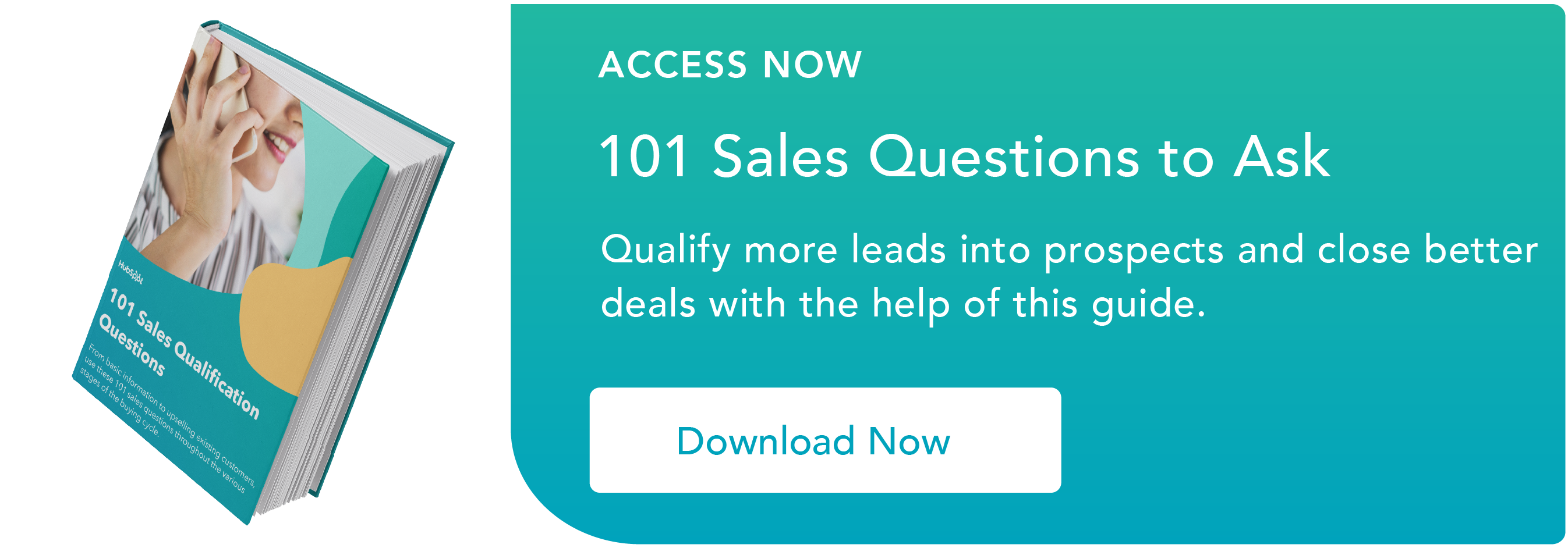Sales managers — and particularly field sales managers — can often feel like they’re trapped in a fog. Without a physical presence in the field, it‘s difficult to keep tabs on their team’s performance.
Instead, they rely heavily on their field representatives to be their eyes and ears. The best way for field managers to gain visibility into their team’s activity is to collect and measure their performance through key performance indicators (KPIs). But it doesn’t take much time researching sales KPIs to see just how many options there are.
As a career marketer, I watch in awe at the impressive relay race that sales teams run. I play a direct role, but I‘m not the one who’s responsible for actually getting the baton across the finish line. I've seen firsthand how easy it is to oversimplify ideas and solutions. The right sales KPIs are your solution.
In this post, I'll explain what KPIs are in sales and all the KPIs and metrics you should measure. I’ll also highlight the latest sales trends from HubSpot’s State of Sales Report and how they could impact your sales KPIs. Read to the end for a free sales KPI template and calculator that you can use to get started measuring your team's performance.

Table of Contents
What does KPI stand for in sales?
KPI stands for key performance indicators. KPI examples in sales can come in many different forms because they measure specific activities. Sales managers, account managers, sales reps, and even marketers have sales KPIs that they should track.
To save you some time, I've narrowed down a list of sample KPIs for sales managers — focusing on the ones I believe are most important to managing field sales teams.
1. Sales Volume by Location
By comparing sales volumes across locations, including physical stores and online transactions, you’ll see where demand for your product is highest and lowest. Then, try to understand why.
I suggest using this information for A/B testing, promotional sales, or samples.
If sales volume is large in region A, perhaps there is a higher demand there, in which case you can focus on customizing certain products and services for that region. Or, if two locations see relatively similar sales volume in January, sales leaders can try implementing a promotional sale in one location and not the other in February to see if it drives sales.
2. Competitor Pricing
While managers and business owners shouldn’t track competitors’ every move, being aware of their pricing can help create a competitive sales strategy. If prices don't differ much, you can consider a price-matching strategy to guarantee your customers the lowest prices — and you the most sales.
Additionally, by keeping track of the average retail price of your products, you can measure the impact of cutting your prices or implementing a promotion.
Pro tip: Make sure you’re training your reps to handle pricing objections appropriately. Try role-play exercises so they're prepared to discuss price without defaulting to discounts.
3. Existing Client Engagement
Maintaining a good rapport with customers after the sale is important to ensure long-term business. Sales reps build trust and maintain good relationships by regularly touching base with their customers. They also get valuable insights into the customer's success with the product and how they can help.
Beyond benefiting your company's business outlook, keeping in touch with clients supports your business’s strategic goals as well — it’s a sales metric that matters.
I recommend asking your salespeople to prioritize customer relationship management by keeping a tally of interactions they have with each of their customers, then comparing the number of touches to the average length of a client relationship.
Example usage: If you notice that your top 10 long-term clients touch base with their sales rep approximately once per quarter, take a deeper look. What do those touch bases look like? How often do reps encounter an issue they're able to help their client solve?
4. Employee Satisfaction
Keeping sales reps motivated improves your bottom line, and there’s a lot that your business can do to inspire your team. Insightful data:
-
86% of surveyed sales professionals say that sales culture is important to job satisfaction.
-
88% say that culture is important to meeting sales goals.
- According to HubSpot research, 67% of sales teams are remote or hybrid.
With a remote workforce, how do you keep your sales force in sync? Do they feel like they‘re part of a team? Do they agree with the sales methods that you’ve implemented?
Pro tip: Employee feedback is crucial to a successful sales culture. KPIs are used not only to measure your team members but also your performance as a manager.
Employee satisfaction can be difficult to quantify, so I suggest using an eNPS survey, along with a few qualifying questions to understand what's making them happy or unhappy, then compare the results against your goal.

5. Upsell and Cross-Sell Rates
Who are the most qualified leads in your CRM? Your existing customers. According to HubSpot's 2024 Sales Trends Report, 76% of sales professionals shared that over 10% of revenue comes from upselling. Another 68% said that 10% of revenue came from cross-selling efforts.
I recommend having your reps track their upsell and cross-sell numbers, and use that data to figure out whether certain verticals respond well to certain product or service pitches.
Example usage: If reps have good luck selling Feature X to clients with Product Package Y six months into their tenure with you — this might be a worthwhile milestone to add to your sales process.
According to 60% of sales professionals, understanding customer challenges helps them sell to current customers. So, look at why, when, how, what, and to whom your reps are upselling and cross-selling, and adjust your efforts accordingly.
6. Sales Cycle Length
Are some reps closing in three weeks while others are closing in six? What are the respective churn rates six months from onboarding? Analyze what sales cycle length produces the highest number of closed-won business.
Pro tip: Look at how successful those deals are down the line. This is a valuable sales KPI for managers to monitor, but a good manager will look at the whole picture.
For example, you may have a rep who's closing business in record time, but you find that their customers are dissatisfied with your solution and often churn after nine months. In that case, a longer sales cycle yields a healthier business.
HubSpot research says that the majority of sales teams (31% of B2B and 35% of B2C) have two to four touches with a prospect through the sales process. Once you have data on your KPIs, analyze the information to understand why you got those results.
7. Close Ratio
Close ratio measures how efficiently a salesperson or team is closing deals based on the leads they‘ve worked. This metric works in conjunction with system touches to help quantify the effectiveness of your sales team’s outreach strategy.
How to calculate: Divide the number of actual closed deals by the number of lead opportunities the salesperson had during a given time period.
8. New Leads
Lead tracking is essential to ensuring your sales team is seizing every opportunity that comes your company's way. I think the easiest way to do this is to implement a lead tracking system or use a CRM that allows you to capture and monitor leads. HubSpot's Free Lead Management & Tracking Software is a great place to get started.
Tracking new leads allows you to:
- Assess the effectiveness of lead-generation efforts.
- Forecast future sales revenue.
- Analyze conversion rates.
- Identify which sources/campaigns are generating the most prospects.
- Allocate resources accordingly.
- Evaluate the health and growth of the sales pipeline.
- Set goals for your sales team.
- Provide performance feedback.
- Analyze the ROI of different marketing initiatives.
- Make informed decisions to optimize lead generation.
Your ability to attract qualified leads is the most influential part of your business, and it's the sales KPI that the owner of EDCO Awards and Specialties tracks most closely. “If the number of qualified leads drops, I know I need to revisit my lead-generation activities like content creation, social media engagement, and sales development outreach,” shared Mike Szczesny.
“While closing deals and revenue are obviously critical, without qualified leads coming in the front end of the sales funnel, there will be no deals or revenue to count on the back end. So for any sales team, I would recommend focusing on and prioritizing your ongoing quest for quality leads.”
9. Product Demos
Monitoring product demos allows you to assess the effectiveness of your teams' sales presentations, understand conversion rates, and evaluate the efficiency of the sales process. In my experience, tracking product demos provides valuable feedback on the product itself, helps set benchmarks and goals for the sales team, and ensures consistent and effective presentations.
Sales managers gather valuable training opportunities from demo conversion rate:
- Track the number of successful demos.
- Analyze the conversion rate from demos to closed deals.
- Identify areas for improvement and provide targeted training and coaching.
10. Sales Revenue
Sales revenue, also known as just revenue or sales, refers to the total amount of money generated from sales of products or services within a given period. This is often measured per month, with monthly recurring revenue (MRR) being one of the most-valued sales metrics in business.
This is a crucial KPI to track as it directly reflects the effectiveness of your sales team and the overall success of your business.
Pro tip: Remember that total sales revenue is not the same as profit because your revenue number doesn‘t include expenses. To assess the profitability of sales activities, it’s necessary to calculate the gross profit or net profit by subtracting the associated costs from the sales revenue.
11. Sales Growth Rate
Sales growth rate measures the increase or decrease in sales revenue over a specific period, typically expressed as a percentage (for example, monthly sales growth). It assesses the change in sales performance or revenue generation from one period to another, such as comparing sales quarter over quarter or year over year.
To calculate the sales growth rate, you would use the following formula:
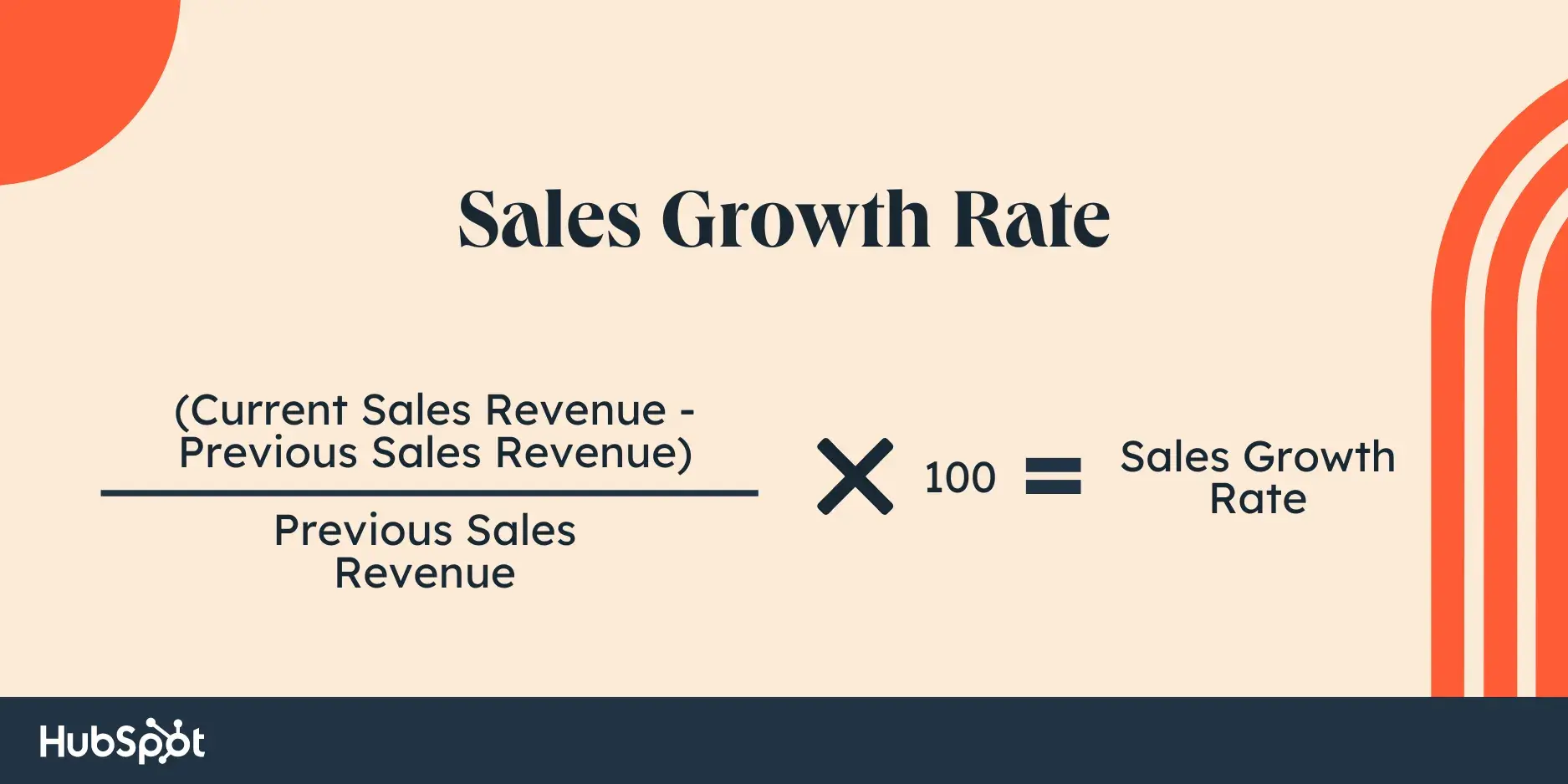
For example, if your company had $100,000 in sales revenue in the previous year and $120,000 in sales revenue in the current year, the sales growth rate would be calculated as:

Your business development representatives (BDR) are actively prospecting, often using cold outreach methods. The examples of sales KPIs I collected below can help managers track BDR performance.
1. Activities
The number of BDR sales activities per rep in a set amount of time can give you an idea of their productivity level. You might consider measuring:
- Number of sales calls.
- Number of emails.
- Meetings scheduled.
Keep in mind that this won't tell the whole story. Some reps may focus on quality over quantity. However, it does give you a baseline for measuring productivity.
2. Opportunities Created
This is a metric that managers consistently monitor. Sales activity means nothing unless it results in tangible pipeline growth. For this reason, I’ve found productivity metrics such as sales activity are best compared to the number of opportunities created by the BDR.
You'll get insight into which activities are working best and which reps are generating the most results from their efforts, answering important questions like:
- How are your salespeople contributing to the expansion of your business in their given territory?
- Who's reaching their quota?
- What percentage of your team is hitting their number?
- Is the quota too high? Too low?
3. Proposals Sent
Whether the BDR nurtures the relationship themselves or hands a prospect to the account manager, the number of proposals sent can give you an indication if BDRs are prospecting to the right people and generating SQLs and opportunities that have a genuine interest.
4. Deals Won
While a BDR isn't responsible for closing business, you want to keep a pulse on how much new business results from your outbound efforts. This sales KPI example monitors the number of deals won per rep and across the rest of the team and can help you make sound decisions when budgeting and reinvesting in sales plays.
5. Client Acquisition Rates
Another commonly used measurement is the rate of client acquisition. Of the new prospects your reps contact, how many convert to customers? It's natural for some salespeople to perform better than others — but if there are large discrepancies between conversion rates, I recommend you dig deeper.
Are lower-performing reps approaching bad-fit prospects? Is there something that over-performers do in sales meetings that others don't?
How to gather and use this data:
- Compare conversion rates to the number of prospects a rep reaches out to.
- If you find that conversions decrease after a certain number of touches, use that number as a benchmark to prevent your reps from getting burned out or stretched too thin.
- Use conversion rates to compare different outreach methods, such as emailing or cold calling, versus pursuing face-to-face interactions.
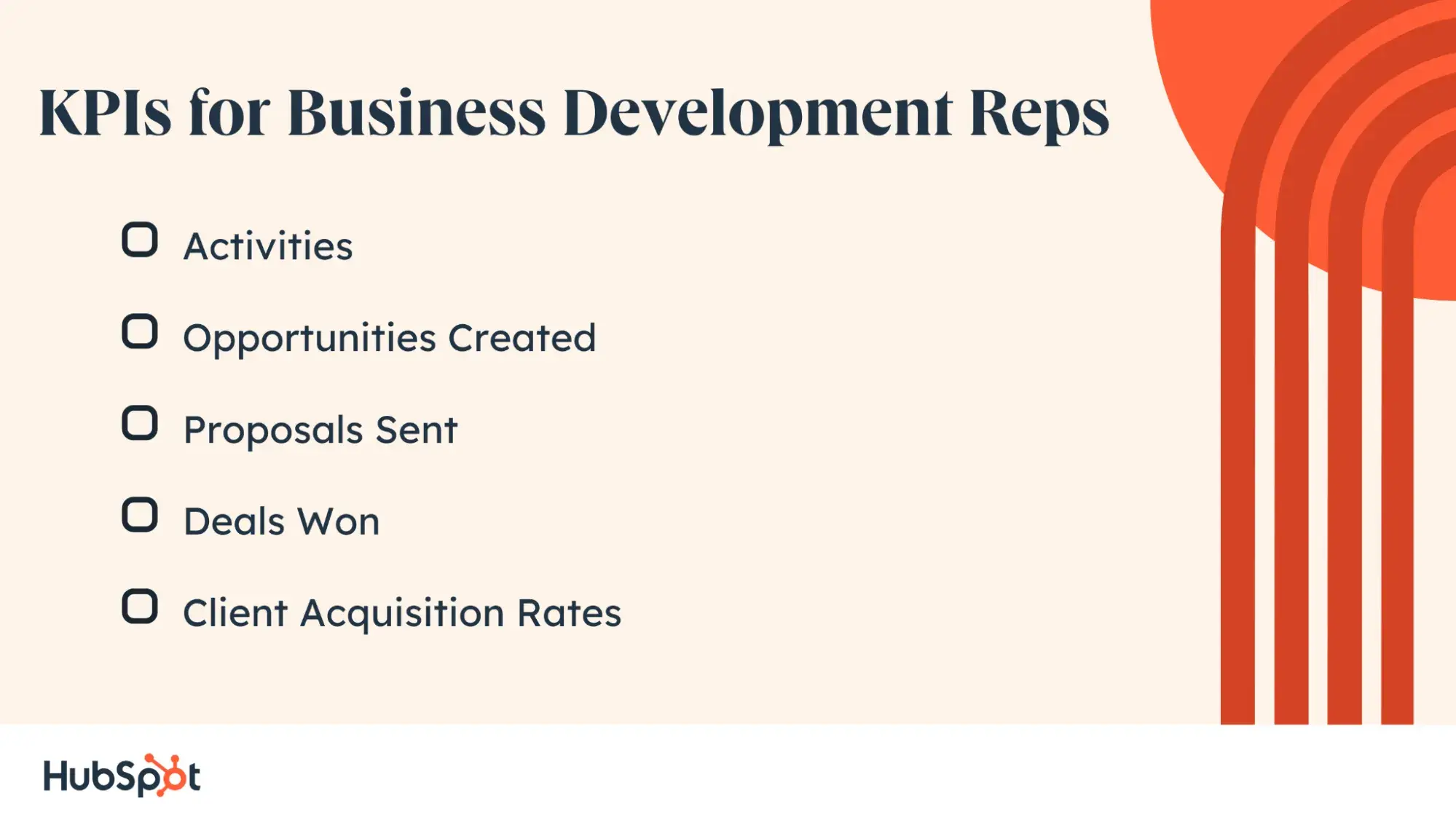
Sales account managers are like business development managers, with a crucial difference. Business development reps focus on new business, while account managers nurture current customers.
Account manager KPIs include metrics mentioned elsewhere on this list, like CLV and upsell and cross-sell revenue. I also think it's smart to track the following KPIs for account managers:
1. Reference-Based Clients
Are your clients also advocates for your business? This KPI gives you an answer that points you directly to which customers are helping your team build more revenue through referrals. Tracking this data allows your team to nurture these important customer relationships, and it's extremely powerful.
Backed by data: 66% of sales professionals think existing customers offer the best leads.
You can track this metric with:
- Social listening.
- Customer feedback surveys.
- Embedded surveys in your onboarding process.
2. Customer Satisfaction Score
This KPI is a popular alternative to the net promoter score. Instead of measuring how likely it is for a customer to recommend your product, it measures how pleased they are with your products, services, and more. It's one of the most important customer service KPIs to monitor.
This metric asks customers to rank how satisfied they are on a scale from one to five (or on a scale of angry emoji to heart-eyes emoji):

Image Source
I like that this sales KPI is easy to calculate and helps with real-time analysis of customer sentiment. It's also helpful at any stage in the buyer journey. Read more about calculating your customer satisfaction score.
3. Customer Churn Rate
As an account manager, another essential KPI is customer churn rate. This metric is the percentage of customers who cancel or don't make another purchase during a specific time period.
While customer churn will always happen, high churn rates can be a sign of:
- Wrong product/market fit.
- Pricing objections.
- Poor customer experience.
Pro tip: Need help reducing customer churn? I suggest reading this post that offers tips for reducing customer churn.
4. Organic Growth
Sales KPIs like sales cycle length and deals won and lost are useful to gauge overall performance, but organic growth in account management comes from the power of relationship-building.
These KPIs may combine or contrast other KPIs to measure the growth of specific industry or client relationships. For example, say you're comparing new customer sales with returning customer sales. You may also want to compare the specific products and revenue generated by these two groups.
Pro tip: To measure this growth and its value, your business may need to create unique metrics, depending on your clients and processes.
5. Customer Outcomes
Customer outcomes measure how well your team is delivering on customer expectations. Some of these metrics are difficult to measure, and these KPIs may be a combination of qualitative and quantitative metrics.
Quantitative customer outcome KPIs can include:
- Revenue.
- Number of support tickets.
- Time on the platform.
- Number of subscriptions.
Qualitative customer outcome KPIs can include:
- Employee comments.
- Customer emails.
- Client testimonials.
This combination of KPIs will help you improve both customer outcomes and expectations.
For example, Amazon has a strong reputation for being customer-centric. It also has a long history of using anecdotal data. A quote from Amazon founder Jeff Bezos says that “...when the anecdotes and the data disagree, the anecdotes are usually right. There is something wrong with the way that you are measuring it.”
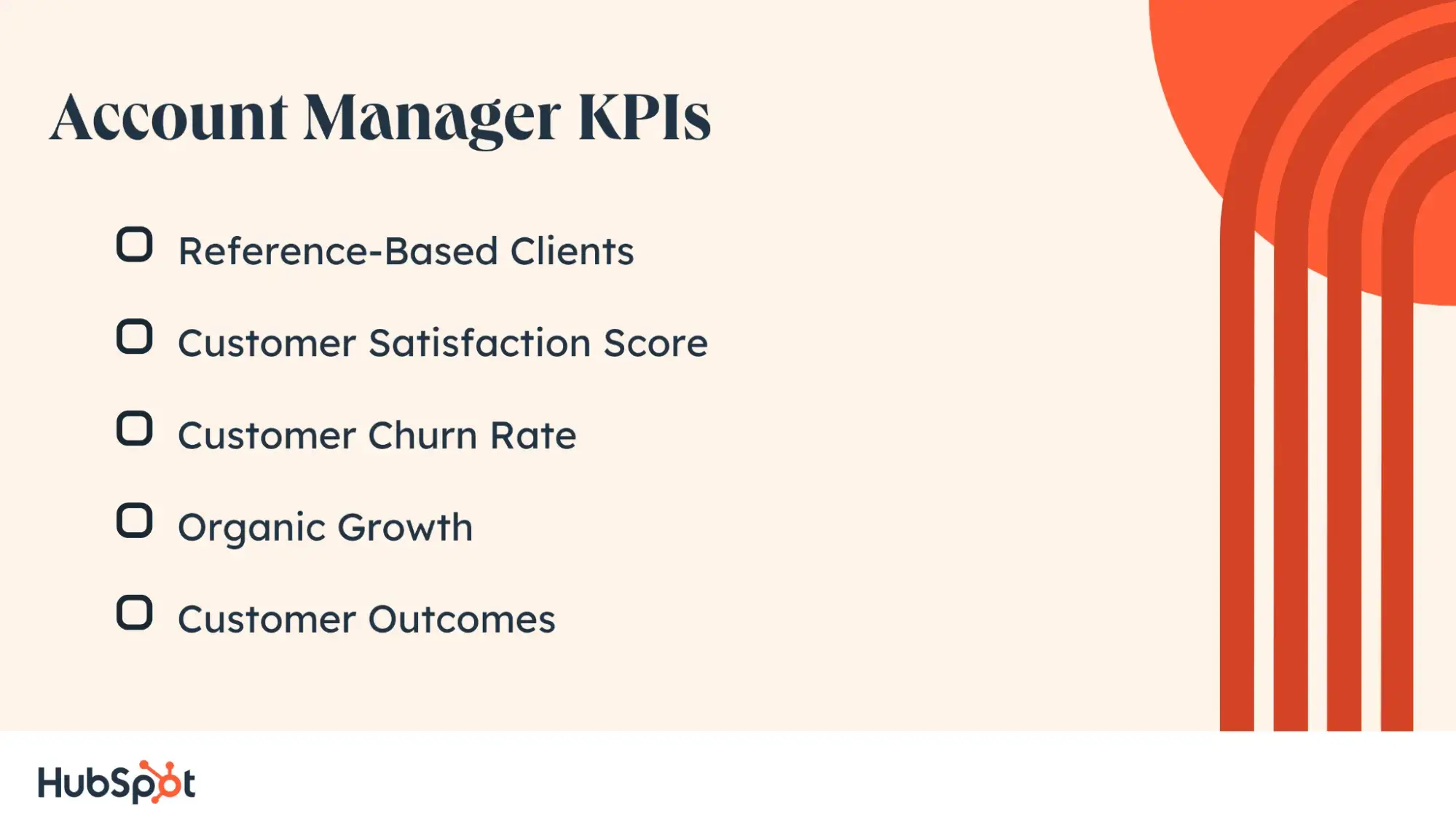
While some of the sales KPI examples in the previous sections may also apply to your sales development representatives, keep in mind that sales development reps (SDRs) primarily respond to inbound leads. For this reason, you should be tracking their performance with these KPIs as well:
1. Average Response Time
If a lead is flagged as qualified by your marketing team, or if that lead indicates interest by filling out a form, there’s no time to waste and no need to keep the lead waiting. I recommend always benchmarking response time and encouraging reps to improve it.
2. Percentage of Leads Followed Up With
Your SDRs should be making contact with all qualified leads. This metric can also give you insight into productivity, bandwidth, and task management.
Tip for managers: If leads are falling through the cracks, assume a neutral position before automatically faulting sales rep productivity. There could be an understandable (and easily addressed) issue sabotaging the pipeline, such as a hiccup with the intake form or a CRM malfunction.
3. Positive vs. Negative Reply Rates
When tracking this KPI, consider all prospect replies through any channel as being binary — the prospect either is or isn’t interested. It’s based on sentiment, not customer acquisition. That’s what differentiates this metric from others.
This is measured at a prospect level, meaning all that matters is the total number of prospects contacted. However, many emails, calls, or other touches it took to contact them aren't reflected in the figure. The metric is expressed as a percentage — so if 50 prospects were contacted and three responded positively, the positive reply rate is 6%.
How SDRs should use this figure: Tag all positive replies and identify trends. This metric can reveal flaws and highlight benefits in aspects of your sales process like outreach cadence, prospecting approach, and channel preferences.
How managers should use this figure: Gain insights into individual processes, and then refine processes for higher conversions.
4. System Touches
A “low touch” sales process is preferred, meaning your salespeople are closing new business efficiently for your company and your consumers. If you review a salesperson’s quarterly numbers and see that they missed their quota and had a high number of touchpoints per closed-lost deals, it might be time to revisit how effective that rep’s strategy is.
Industry trend: Per HubSpot research, a more efficient sales process is a top goal for 29% of sales professionals.
I recommend managers analyze their most successful reps’ average touchpoints. Do their closed-won deals average three video meetings, eight emails, and four phone calls? Ask these reps to share their sales strategies, techniques, and advice to streamline your team's average, collective sales cycle.
5. Meeting Acceptance Rates
Consistently landing appointment acceptances is a mark of an exceptional sales rep. Prospects often try to push meetings off, don’t take them seriously, or just stop responding. If an SDR lands meetings on a regular basis, it means they’re making their prospects prioritize your product or service in their schedules.
How to calculate this rate: Divide the number of meetings a rep schedules by the total number of replies they receive from prospects.
If this rate is low, both sales representatives and managers can leverage this insight:
-
Sales reps: Role-play objection handling.
-
Sales managers: Improve the efficacy of your sales training.
Pro tip: When possible, I recommend gathering this data automatically.
"In a healthy sales organization, managers can keep an eye on overall health and see individual contribution so they can watch for risks or rock stars," shared Sara Lobkovich, principal consultant at Red Currant Collective. “Leverage helpful data that can be automated as much as possible so that sellers can focus on selling, not on data quality and data management!”
6. SQL-to-Customer Conversion Rate
Your SDRs may not have much control over how many sales-qualified leads (SQLs) are generated, but they impact turning those leads into customers. A low SQL-to-customer conversion rate can mean different things:
- Low conversion rates across the board can indicate an issue with your lead generation and qualification process.
- Low conversion rates with specific reps can help you make decisions about ongoing training and development.
Paula Glynn, director of PixelStorm, says that lead conversion rate is the sales KPI she finds most important, but that sales managers and sales reps look at this number differently.
“Sales reps are focused on bringing in high numbers of closable leads, and sales managers are using the metrics produced by the sales team to fuel the sales pipeline,” Glynn shared. “For me as a manager, I use the sales KPIs to help with bigger-picture things: forecasting and investment. So if ‘X’ number of leads are needed, I need investment to help generate those leads.”
7. Deal Win-Loss Ratio
While SDRs may not be involved in closing the deal, the win/loss ratio can indicate the quality of the experience the prospect had along the way.
For organizations with sales and marketing departments, it can be difficult to measure sales performance. After all, how do you know the handoff is successful? Recent research says that 52% of sales and marketing teams don‘t feel they’re aligned. And 33% of respondents feel that this keeps both teams from reaching their goals.
Here are KPIs that can give you a clue:
1. Percentage of Leads in Each Lifecycle Stage
If you break down leads by lifecycle stage (such as lead, marketing-qualified lead, SQL), you can try to diagnose pipeline issues between the departments.
Marketing is responsible for increasing the percentage of leads that make it to MQL. Then, they hand off to sales. Sales handles turning SQLs into opportunities. But if Sales isn’t getting the right leads, sales numbers will be affected.
2. MQL-to-Customer Conversion Rate
Both Marketing and Sales have an interest in the MQL-to-customer conversion rate. Marketing is invested because they supply the MQLs, and Sales is invested because they turn those MQLs into customers. Raising this number should be a shared objective.
3. Average Length of Customer Lifecycle
The customer lifecycle refers to the different stages a customer goes through on their path to purchase (and beyond). It‘s in an organization's best interest to decrease the time between first impression and first purchase — in theory, that will reduce acquisition cost and generate customers more efficiently.
Marketing and Sales both have a stake in this lifecycle and can continue to iterate improvements to shorten it.
4. Volume of New Opportunities
To achieve alignment between sales and marketing teams, I think tracking the volume of new opportunities is important. Before measuring this KPI, both teams will need to agree on what a new opportunity is.
While there is no universal definition, a sales opportunity is usually a qualified prospect who has a high probability of becoming a customer. The sales pipeline begins with opportunities, which turn into deals and customers.
Marketing and sales must work together to qualify leads and create more opportunities, but alignment isn‘t something that always happens. "In my time as a sales leader, I saw many performance metrics driven among the sales teams that were actually counter-productive to achieving the company’s core goals," shared sales strategist Andee Hart.
“It's important that sales KPIs be 1) aligned with the strategic initiatives of the overall company, 2) drive profitable and sustainable revenue growth, and 3) be aligned with adjacent teams' core competencies.”
5. Cost Per Lead
This metric helps quantify the success of a marketing campaign by measuring how well leads are making their way from marketing to sales. The lower the cost per lead, the more effective the campaign is at bringing in leads for the sales team.
How to calculate: Divide the campaign budget by the number of leads acquired from the campaign.
6. Cost Per Acquisition
From market research to deal closed, cost per acquisition measures every effort a business takes to acquire a new customer and identifies the exact dollar amount that was spent to welcome that new customer on board.
An acquisition may be defined in different ways, such as:
- Form fills.
- Asset downloads.
- Actual deals closed.
By comparing this metric over time, your marketing and sales teams can learn what works and focus on those activities. In turn, the cost per acquisition should decrease, making both teams more efficient at closing new business.
Pro tip: Compare customer acquisition cost to customer lifetime value.
“This ratio provides a clear vision of the ROI for acquiring a new customer,” shared Jayanti Katariya, CEO of Moon Invoice. “A higher ratio indicates more value derived from customers over their lifetime relative to the cost of acquiring them. This ratio is very helpful for subscription-based businesses.”
7. Customer Retention Rate
Just because a customer signed a contract with your company doesn‘t mean you’re done earning their business. Tracking how well your team is meeting the customer's needs is key to customer retention. Customer retention measures how well a business retains its customers and their revenue over time.
While there are several ways you can measure customer retention, I think it's easier to have a single metric to review on a regular basis. You can calculate a single number by measuring customer retention rate with this formula.
8. Average Revenue Per Account
Understanding the average revenue for an account can help your marketing team identify audiences with more relevant campaigns. Your sales team can also use this information to take an account-based selling approach to new prospects with similar business models to accounts with high average revenue.
9. Net Promoter Score (NPS)
Your NPS is a measurement of how likely customers are to recommend your product/service to someone else.
The survey asks participants to rank the likelihood of a recommendation on a scale of 0-10. Their numerical ranking is divided into three categories:
-
Promoters (9-10): They like you — they really like you. Not only will these customers likely renew, but they also won't hesitate to recommend you to friends or colleagues.
-
Passives (7-8): They’re satisfied, but that's about it. Passives feel your product/service is status quo.
-
Detractors (0-6): They don’t like you — they really don't like you. Detractors will likely churn, might tell others to avoid doing business with you, and will do the most damage to your brand.
The cadence of the survey depends on your business and goals. As a rule of thumb, I suggest you start by sending an NPS every three-to-six months.
Pro tip: Don’t send your survey too early to new customers; let them fall in love with you first!
To calculate your score, subtract the percentage of detractors from the percentage of promoters. You can also use this handy NPS formula.
10. Customer Lifetime Value (CLV)
Customer lifetime value indicates the total revenue a business can reasonably expect from a single customer account. It considers a customer’s revenue value, comparing that number to the predicted customer lifespan.
It's a crucial metric to figure out which customer segments or buyer personas will drive the most revenue for a company. The applications aren’t limited to accounting for broad portions of your customer base. The figure can also be used to gauge the value of individual accounts and, in turn, your account managers’ ability to engage existing clients.
Their ability to consistently offer value to their clients can be measured, in large part, by the value they offer back.
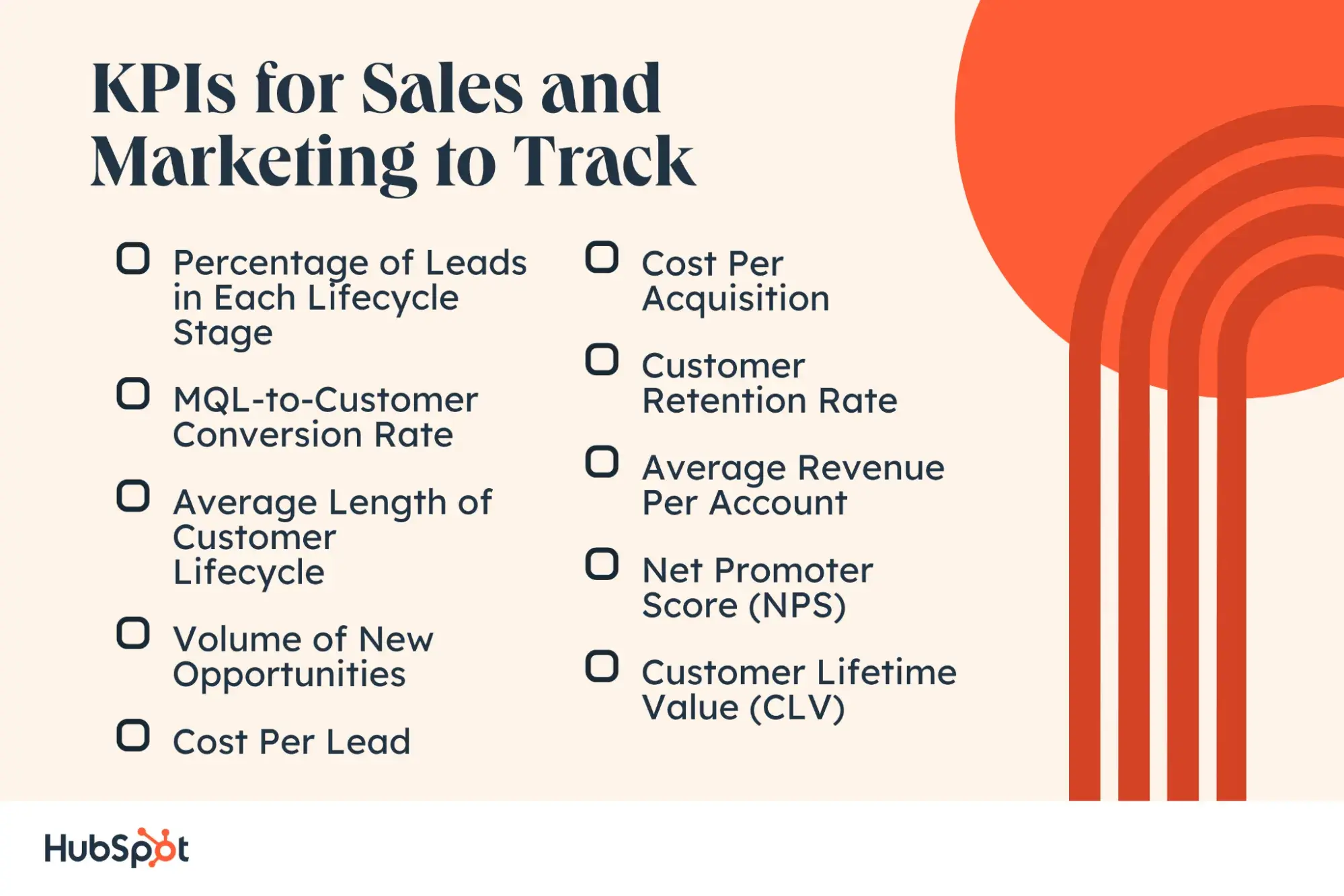
Sales KPI Template & Calculator

I know these can be a lot of KPIs to keep track of, and by no means do you need to start measuring each of these next quarter. Below are the best sales metrics to track when you're first starting. All of these metrics can be calculated in this free template.
-
Average Deal Size: Measure this metric when you first get started to set a benchmark for future goals.
-
Win Rate: Gauge how many closed-won deals your team is closing.
-
Demo-Close Ratio: Accurately forecast your pipeline by understanding how many demos your sales reps are scheduling.
-
Quota Setting Calculator: Know rather than guess what your team's quota should be next quarter.
-
Commission Calculator: Set up a fair and attainable compensation structure for your team.
-
Customer Acquisition Cost (CAC): See how much it costs your business to bring a customer on board.
-
Customer Lifetime Value (CLV): Determine the value that your customers will bring over the entire time that they do business with you.
-
CAC-to-CLV: A ratio to determine how much it costs to bring a customer on versus the value they bring over time.
-
Revenue by Product: Understand which products bring in the most sales so your team can sell strategically to meet the customers’ and the business’s needs.
-
Customer Retention Rate: Measure how many customers continue doing business with your company over time.
-
Revenue Churn: Measure how many customers stop doing business with your company over time.
-
Employee Turnover Rate: Track how many employees leave the company in a given time period.
Track KPIs That Matter
What's your big takeaway from these sales KPIs? Mine is that no one is ever short of opportunities to improve their sales pipeline.
Avoid the overwhelm by using our Sales Software to help you accelerate revenue growth and streamline your sales process.
Editor's note: This post was originally published in June 2019, and has been updated for comprehensiveness.




 If you were foolish enough to listen to some B2B marketers and agencies, you might conclude that the simple act of developing a generic “unique value proposition” for your organisation would somehow automatically make you more relevant to your prospective customers.
If you were foolish enough to listen to some B2B marketers and agencies, you might conclude that the simple act of developing a generic “unique value proposition” for your organisation would somehow automatically make you more relevant to your prospective customers. Bob Apollo
Bob Apollo




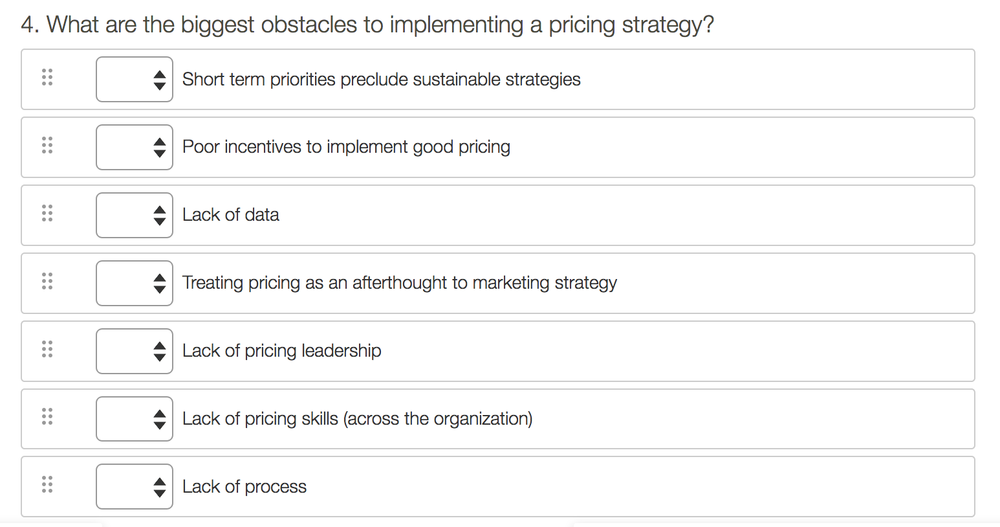








 Recurring Services – Classes, regular maintenance, consulting. A few good examples of a recurring service would be pest control, an art class, a personal trainer, a salon, or even a dentist. These types of services may happen annually, every month, or week. Obviously, there is a difference in price, depending on the service. But, generally speaking, these types of services are typically more affordable than a one-time service.
Recurring Services – Classes, regular maintenance, consulting. A few good examples of a recurring service would be pest control, an art class, a personal trainer, a salon, or even a dentist. These types of services may happen annually, every month, or week. Obviously, there is a difference in price, depending on the service. But, generally speaking, these types of services are typically more affordable than a one-time service.






















 If you have opinions, confidently express them. If you’re always an optimist, end with your favorite motivational quote. If you pride yourself on being irreverent, then tell it how it is! Heck, if you’re the king of “dad jokes,” include one. (How do you make a Kleenex dance? Put a little boogie in it!) Remember, this is your first impression. Make a splash right from the get-go. If you do this right, your readers will eventually be able to recognize your voice in every stage even if your logo and brand colors go missing from your emails. And they’ll be even more excited to open your next email. 2. Avoid R.O.T. (redundant, outdated, and/or trivial information). Your content has to be valuable. A subscriber joined your list because they think you can help them solve their problem. Sure, you may have a free lead magnet to entice them, but that content still needs to be high-quality, fresh, creative, and useful. If it’s just something your subscribers can find on Google or your emails are full of content that your competitors also provide, they’ll bounce out of your list and never make it to the next email in your series. 3. Tell stories. Humans love stories. We communicate through them. We learn from them. Our personal stories and memories give our lives meaning and order.
If you have opinions, confidently express them. If you’re always an optimist, end with your favorite motivational quote. If you pride yourself on being irreverent, then tell it how it is! Heck, if you’re the king of “dad jokes,” include one. (How do you make a Kleenex dance? Put a little boogie in it!) Remember, this is your first impression. Make a splash right from the get-go. If you do this right, your readers will eventually be able to recognize your voice in every stage even if your logo and brand colors go missing from your emails. And they’ll be even more excited to open your next email. 2. Avoid R.O.T. (redundant, outdated, and/or trivial information). Your content has to be valuable. A subscriber joined your list because they think you can help them solve their problem. Sure, you may have a free lead magnet to entice them, but that content still needs to be high-quality, fresh, creative, and useful. If it’s just something your subscribers can find on Google or your emails are full of content that your competitors also provide, they’ll bounce out of your list and never make it to the next email in your series. 3. Tell stories. Humans love stories. We communicate through them. We learn from them. Our personal stories and memories give our lives meaning and order.









 Your goal should be to convert your website visitors into sales and brand ambassadors. Inbound Marketing can help you accomplish just that through a well executed inbound program that gets you found by your
Your goal should be to convert your website visitors into sales and brand ambassadors. Inbound Marketing can help you accomplish just that through a well executed inbound program that gets you found by your 
![Free Download: 101 Sales Qualification Questions [Access Now]](https://no-cache.hubspot.com/cta/default/53/e97d6603-b40e-4085-ad55-0074b7351ead.png)
.webp)
.webp)
.webp)
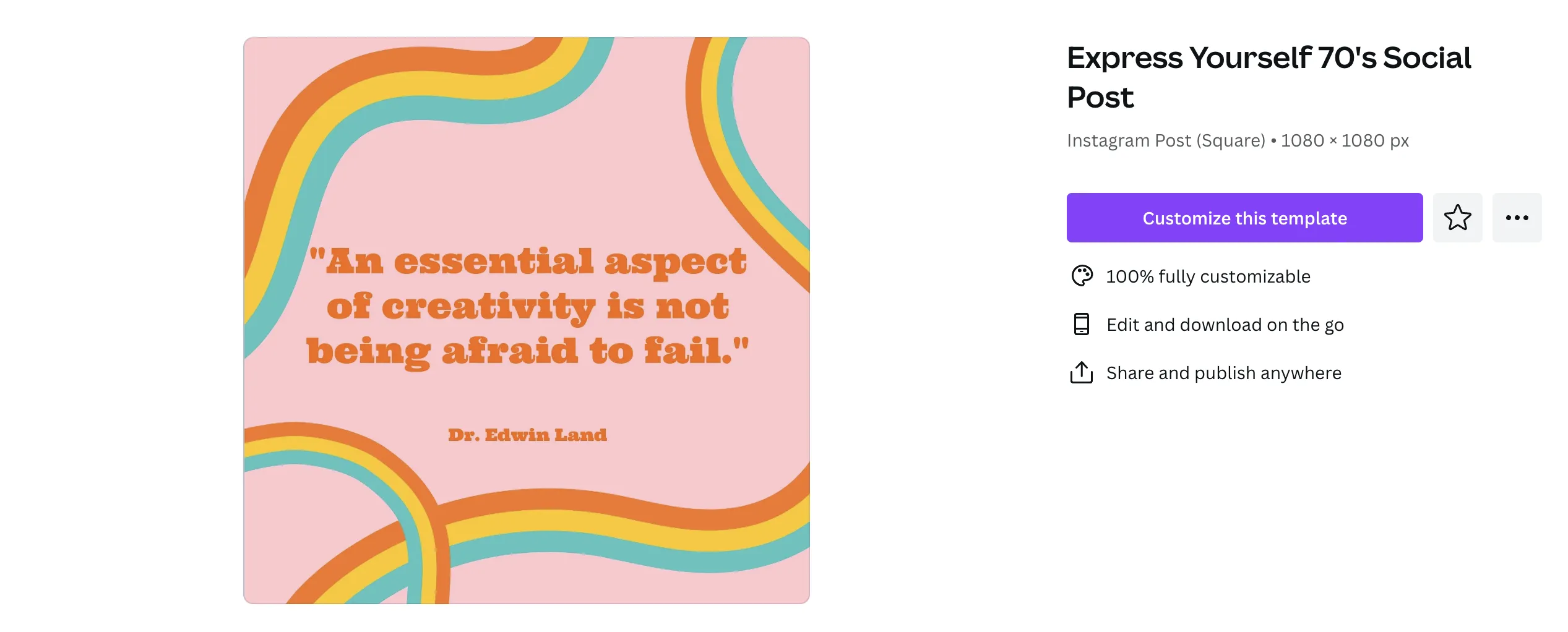
.webp) Image Source
Image Source Image Source
Image Source